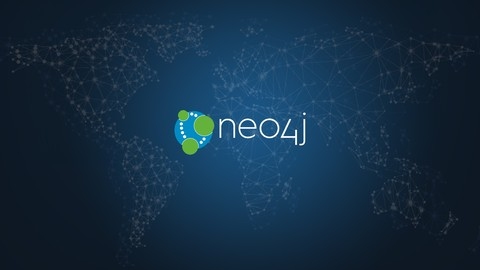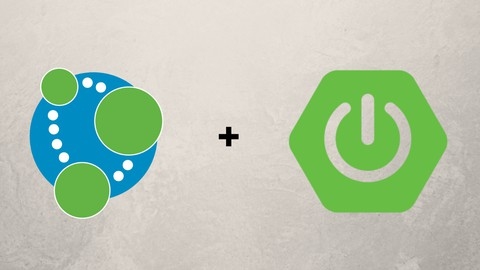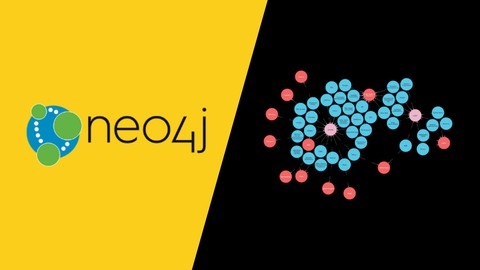Neo4j: GraphDB Foundations with Cypher
You will start by learning the fundamental concepts of graphs and how they differ from traditional databases.
The course then guides you through installing Neo4j on Windows or Mac and familiarizes you with its various components, such as the Desktop Command Bar, Bloom, and the Browser interface.
Once you have set up the environment, the course dives into querying basics with Cypher, Neo4j’s query language.
You will learn how to match nodes and relationships, filter data using WHERE clauses, comparison operators, and Boolean operators.
The course also covers transforming query results with ORDER BY, LIMIT, SKIP, and AS.
Additionally, you will explore aggregation functions like COUNT, AVG, SUM, MIN, and MAX, as well as string and math functions.
Moving forward, you will learn how to create new nodes and relationships, as well as how to update and delete existing data.
The course covers setting and removing properties and labels, changing relationship types, and working with NULL values and Boolean logic.
The MERGE clause is introduced, which allows you to create or update data based on conditions.
You will also learn about working with paths, including finding nth-degree relationships, variable-length paths, path lengths, and shortest paths.
Throughout the course, you will have opportunities to practice what you’ve learned through various exercises, with solutions provided to reinforce your understanding.
Finally, the course provides information on the Neo4j Community, where you can find help and participate in discussions.
NoSQL: Neo4j and Cypher (Part: 1-Beginners)
You’ll start by learning what graph databases are and how they differ from traditional relational databases.
The course covers the history of graph databases, setting up Neo4j, and getting started with the Cypher query language.
You’ll learn how to create your first graph node, add properties to nodes, and use the MATCH command to query the graph database.
The course covers array properties, updating node properties, and using the WHERE and REMOVE clauses in Cypher queries.
The course dives into relationships in Neo4j, including creating your first relationship, querying the graph using relationships, and creating bi-directional relationships.
You’ll learn how to delete relationships and create new nodes and relationships simultaneously.
The course also covers modifying properties on relationships, using the MERGE command with nodes and relationships, and the CREATE UNIQUE command.
Throughout the course, you’ll find explanations of key concepts and hands-on exercises to reinforce your learning.
The course concludes with a quiz to test your understanding of Neo4j and Cypher.
Upon completion, you’ll receive a coupon code for the intermediate-level Neo4j and Cypher course, allowing you to continue your learning journey.
NoSQL: Neo4j and Cypher (Part: 2-Intermediate)
This course starts with an introduction and guides you through setting up Neo4j on your system.
You’ll then dive into a case study called the “Learning Market Place” to apply the concepts you learn throughout the course.
The meat of the course focuses on working with patterns and paths in Neo4j using Cypher.
You’ll learn how to filter nodes based on labels, work with connected nodes, and use the WITH clause for managing query flow.
The course also covers aggregation functions like COUNT, MIN, MAX, SUM, and COLLECT for analyzing and summarizing data.
You’ll explore variable length paths, which allow you to find patterns spanning an arbitrary number of relationships.
This is useful for tasks like recommendation engines or fraud detection.
Text searching capabilities in Cypher are covered as well, allowing you to perform full-text searches on node properties.
You’ll learn about predicates like IN for filtering data and collection predicates for working with lists.
Sorting, limiting, and pagination techniques are taught, which are essential for building web applications that need to display data in chunks.
The course dives into conditional expressions for adding logic to your queries.
Finally, you’ll learn web development techniques like using Neo4j’s REST API to build applications that interact with the database over HTTP.
The hands-on case study will help you apply the concepts to a real-world scenario.
2024 Complete Neo4j GraphDB Bootcamp: Zero to Hero (Updated)
You will start by learning the fundamentals of data modeling in Neo4j, including how to create nodes, relationships, and properties.
The course covers the core Cypher query language in depth, teaching you how to use clauses like MATCH, CREATE, RETURN, and more to query and manipulate graph data.
One key focus is understanding patterns and pattern matching, which are central to working with graph databases.
You’ll learn variable length patterns, shortest paths, and how to use pattern comprehensions.
The course also dives into important Neo4j features like constraints, the MERGE clause for upserting data, handling null values, commenting, and using parameters.
More advanced topics are covered as well, such as using lists, maps, and the WITH clause for query refactoring.
You’ll learn aggregation functions like COUNT, SUM, and AVG, as well as string and mathematical functions.
The LOAD CSV functionality for importing tabular data is explored in-depth.
The course teaches you how to use APOC (Awesome Procedures on Cypher) for tasks like quickly generating test data.
You’ll also learn how to integrate Neo4j with Python using the official driver.
Hands-on challenges reinforce the concepts throughout.
Learn to build apps using Neo4j
The course starts with an introduction to graph databases, explaining what they are and how they differ from traditional relational databases.
You’ll learn about the graph data model that Neo4j uses.
Next, you’ll get started with Neo4j itself.
The course covers installing Neo4j on Windows and Linux, as well as the Neo4j browser interface.
This will give you a hands-on environment to start working with Neo4j.
A major focus is learning Cypher, the query language used with Neo4j.
Using a movie graph example, you’ll learn how to create and match nodes, create relationships between nodes, and update or delete nodes and properties.
The course dives deeper into other Cypher queries and clauses.
You’ll also learn about Neo4j’s HTTP REST API and how to use language drivers to interact with the database from your applications.
This is put into practice with a project where you build a SocialClient application using Node.js and Express.
You’ll set up a server, connect to Neo4j with a driver, and add nodes, relationships, and a Twitter Bootstrap UI with details page forms.
Throughout the course, you’ll have quizzes to reinforce the concepts you’ve learned about graph databases, Neo4j, and Cypher.
Graph Database : Neo4j with Spring Boot
You’ll start by learning the fundamentals of Neo4j, including nodes, relationships, and properties.
You’ll gain hands-on experience installing Neo4j Desktop, creating projects and databases, and using the Neo4j Browser.
The course dives deep into CRUD operations with Neo4j’s Cypher Query Language (CQL), covering everything from creating and finding nodes to updating and deleting them.
You’ll also learn about relationships, adding them between nodes, fetching, updating, and deleting them.
Constraints in Neo4j are covered in detail, including unique constraints, property existence constraints, node key constraints, and dropping constraints.
The course also explores string comparisons, aggregate functions, pagination, and sorting in Neo4j.
In the second part, you’ll learn how to integrate Neo4j with Spring Boot.
You’ll set up a Spring Boot application and map entity classes, relationships, and relationship properties using Spring Data Neo4j.
The course covers using the Neo4jRepository for CRUD operations, executing Cypher queries, pagination, sorting, and more.
Throughout the course, you’ll encounter “Knowledge Brush Up” sections that reinforce the concepts you’ve learned.
Neo4J Cypher By Examples™: Master Neo4j Programming Quickly
The course starts with an introduction and case study demos to give you a practical understanding of Neo4j and Cypher.
You’ll learn how to create nodes, labels, and properties, including using the asterisk and the difference between CREATE and MERGE.
The course dives deep into working with nodes, covering everything from creating empty nodes to adding labels and properties using various techniques.
Once you’ve mastered nodes, you’ll move on to paths, relationships, and more advanced concepts.
You’ll learn how to create relationships with properties, handle multiple relationships between nodes, and return relationship details.
The course also covers updating properties using SET, CASE statements, data type conversions, and removing properties.
Deleting nodes, relationships, and the entire graph is also covered, ensuring you have a well-rounded understanding of data management in Neo4j.
The course then explores MATCH and RETURN statements, including filtering, ordering, and aggregating results.
You’ll learn how to work with patterns, use WHERE clauses for filtering, and leverage subqueries and nested Cypher queries.
The course also covers advanced topics like ORDER BY, COUNT, SKIP, WITH, COLLECT, OPTIONAL MATCH, and UNION.
Additionally, you’ll learn how to use parameters and LOAD CSV for importing data.
The course also introduces APOC (Awesome Procedures on Cypher), covering various APOC procedures for creating nodes, relationships, and more.
The course includes hands-on exercises and solutions to reinforce your learning, ensuring you gain practical experience with Neo4j and Cypher.
Knowledge Graph Solutions using Neo4j
You’ll start with an overview of knowledge graphs, including their definitions, types, features, and key capabilities.
This lays the foundation for understanding why graph databases like Neo4j are so powerful for managing highly connected data.
The course then dives into setting up a Neo4j sandbox environment, which allows you to follow along with hands-on examples.
You’ll learn how to create nodes and relationships using the Cypher query language, as well as how to import data from CSV files.
These practical exercises will give you valuable experience working with graph data structures.
As you progress, the course covers more advanced topics like Neo4j’s library ecosystem.
This includes the APOC library for advanced cypher queries, the Neosemantics library for working with knowledge graphs, and the Graph Data Science library for running algorithms on your graph data.
You’ll also learn how to visualize your graphs using the Bloom visualization tool.
One of the standout features of this course is its coverage of integrating Neo4j with Python.
You’ll learn how to use the Python SDK driver to interact with your Neo4j database from Python scripts and applications.
This opens up a world of possibilities for building data-driven applications on top of your knowledge graphs.
Throughout the course, you’ll work on exercises and a final project to solidify your understanding of the material.
The instructors provide clear explanations and demonstrations, making it easy to follow along even if you’re new to graph databases.
You’ll gain practical skills for working with graph data, as well as an understanding of the powerful capabilities that Neo4j brings to the table.
Understanding Graph Databases With Neo4j
You will start by learning the fundamentals of graph theory and how it is utilized in graph databases for queries and algorithms.
This theoretical foundation will be followed by a comparison of different database types, including graph, relational, and document-oriented databases, to understand their strengths and weaknesses.
Moving on, the course delves into real-world use cases of graph databases, such as land use planning, legacy review, master data broadcast, 360° views, and data labs.
These examples will provide you with a practical understanding of how graph databases can be applied in various domains.
A significant portion of the course is dedicated to hands-on experience with Neo4j, a popular graph database.
You will learn how to write basic queries, relation queries, write queries, path queries, and perform aggregations in Neo4j.
Additionally, you will explore advanced algorithms like PageRank, Jaccard Similarity, and Louvain Community Detection, which are essential for analyzing and deriving insights from graph data.
Throughout the course, you will gain a solid understanding of graph theory, database comparisons, real-world use cases, and practical experience with Neo4j.
Learn MongoDB & Neo4j - Leading NoSQL Databases from scratch
This course starts with an introduction to NoSQL databases and MongoDB, covering the key differences between MongoDB and traditional relational databases.
You’ll learn how to install and configure MongoDB on various platforms like Windows, Linux, and macOS.
The course dives deep into the basics of MongoDB, teaching you how to create databases, collections, and insert documents using methods like insertOne() and insertMany().
You’ll master CRUD (Create, Read, Update, Delete) operations and learn about essential concepts like indexes for performance tuning and ObjectIds for document identification.
Data modeling is a crucial aspect covered in detail, including techniques like embedding and referencing for handling relationships between data.
The course also explores advanced topics like the Aggregation Framework, Map-Reduce, and regular expressions in MongoDB.
To solidify your learning, you’ll work on a project using Node.js and MongoDB, building an HTTP server, creating project structures, and performing CRUD operations with the MongoDB Node.js driver.
The course prepares you for MongoDB interviews by covering common questions and topics like namespaces, primary-foreign key relationships, and MongoDB’s key features.
Moving on, you’ll dive into replication and sharding in MongoDB, learning about replica set architecture, elections, voting members, and how to set up sharded clusters for horizontal scaling.
The course introduces you to various MongoDB tools like NoSQL Manager, Robo 3T (Robomongo), Studio 3T (MongoChef), and MongoDB Compass.
You’ll learn how to use these tools for tasks like backup and restore, importing CSV data, and performing basic CRUD operations.
Additionally, the course covers MongoDB Atlas, MongoDB’s cloud-based service, guiding you through creating a cluster, managing users, and connecting to the cluster using different tools.
As a bonus, the course includes an introduction to Neo4j, a popular graph database.
You’ll learn about Neo4j’s data model, Cypher Query Language (CQL), creating nodes and relationships, CRUD operations, and working with functions and aggregations in Neo4j.










